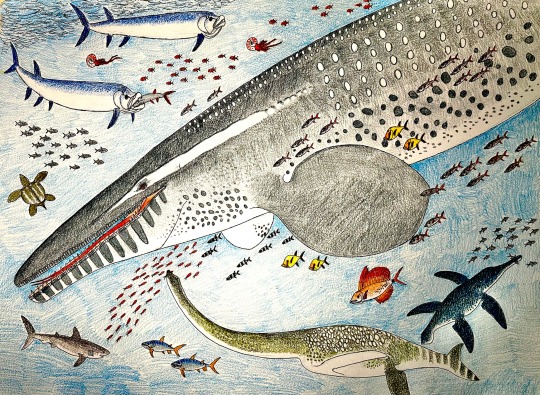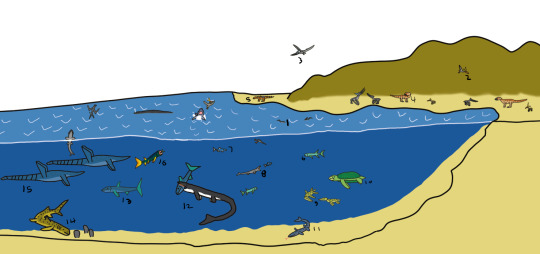#tylosaurus proriger
Explore tagged Tumblr posts
Text

i’m goin’ away for a long time
#inspired by whale falls lol#got the idea while brainstorming with a friend n stuff#tylosaurus#tylosaurus proriger#mosasaur#mosasaurid#mosasauridae#marine reptile#marine reptiles#prehistoric animals#prehistoric wildlife#reptiles#cretaceous#late cretaceous#mesozoic#paleontology#paleoart#paleoblr#cw thalassophobia#my art
42 notes
·
View notes
Text

Art of Tylosaurus proriger (proportions might be off)
24 notes
·
View notes
Text

"The sea which once covered the plains"
1. Elasmosaurus platyurus 2. Liodon [Tylosaurus] proriger 3., 4., 5. Ornithochirus [Ornithocherius] umbrosus 6. Ornithochirus [Ornithocherius] harpyia 7. Protostiga [Protostega] gigas 8. Polycotylus latipinnis
From Buffalo land; an authentic account of the discoveries, adventures, and mishaps of a scientific and sporting party in the Wild West by William Edward Webb, 1872
https://www.biodiversitylibrary.org/bibliography/18649
#elasmosaurus#liodon#tylosaurus#ornithocheirus#ornithochirus#protostiga#protostega#polycotylus#plesiosaur#pterosaur#pterodactyl#mosasaur#turtle#1872#william edward webb#buffalo land
7 notes
·
View notes
Text
Tylosaurus proriger with company

#paleoart#mosasaur#mosasaurs#mosasaurid#tylosaurus#niobrarachalk#late cretaceous#xiphactinus#dolicorhynchops#styxosaurus#protostega#western interior seaway#paleontology#paleontography
124 notes
·
View notes
Text













Nyctosaurus is a genus of nyctosaurid pterosaur which lived throughout what is now the Midwestern United States and possibly Brazil during the Santonian to Campanian of the Late cretaceous some 87 and 82 million years ago. The first known remains of nyctosaurus consisting of a fragmented skeleton was recovered from the Smoky Hill River site in Kansas and were described in 1876 by Othniel Charles Marsh. Marsh referred the specimen to a species of his new genus Pteranodon, as Pteranodon gracilis. Later that year, Marsh reclassified the species in its own genus, which he named Nyctosaurus, meaning "night lizard" or "bat lizard", in reference to the wing structure somewhat paralleling those of bats. In 1881, Marsh incorrectly assumed the name was preoccupied and changed it into Nyctodactylus, which thus is now a junior synonym. In 1901 H. T. Martin recorverd a remarkably complete specimen which was described by Samuel Wendell Williston who assigned it as nyctosaurus giving a much better picture and understanding of the animal. Since then several additional specimens have been recovered with there being at least 2 species: N. gracilis & N. nanus. Reaching around 1 to 2ft (30 to 60cms) in length, 4-6lbs (1.8 to 2.7kgs) in weight, with a 6.6 to 9.5ft (2 to 2.9m) long wingspan, nyctosaurus sported many similarities to its much larger contemporary pteranodon such as a comparatively small body, long wings, large heads, and elaborate head crests. In nyctosaurus the crest is composed of two long, grooved spars, each as long or longer than the body, with one pointed upward and the other backward, arising from a common base projecting up and back from the back of the skull. Fairly unique amongst pterosaurs nyctosaurs lost most of the wing fingers except the "flight" digit. As a result, nyctosaurus likely had a hard time walking let alone climbing and likely spent almost all of its time on the wing.
Art used can be found at the following links
#pleistocene pride#pliestocene pride#mesozoic#pterosaur#cretaceous#nyctosaurus#extinct#animal#animal facts#prehistoric#dinosaur#western interior seaway
4 notes
·
View notes
Text

A mosasaur jaw of a Tylosaurus sp. from the Pierre Shale in Phillips County, Kansas, United States. The species Tylosaurus proriger and Tylosaurus pembinensis are both described from this deposit; the replacement teeth suggests it belongs to the former.
#mosasaur#fossils#paleontology#palaeontology#paleo#palaeo#tylosaurus#tylosaurinae#mosasauridae#cretaceous#mesozoic#prehistoric#science#paleoblr#ティロサウルス#モササウルス科#化石#古生物学
13 notes
·
View notes
Text









Tylosaurus proriger snout
10 notes
·
View notes
Text

Tylosaurus proriger, a large predatory marine reptile of the Late Cretaceous.
#tylosaurus#marine reptile#reptile#paleoart#paleontology#mesozoic#cretaceous#palaeontology#palaeoart#ocean#digitalart
18 notes
·
View notes
Text

Tylosaurus proriger and Elasmosaurus platyurus, by Zdeněk Burian,1963
11 notes
·
View notes
Text


Mosasaur (either Tylosaurus proriger or Mosasaurus hoffmanni) skull and Tylosaurus mural (artist Charles Knight) from the Chicago Field Museum
2 notes
·
View notes
Text
SEASON'S GREETINGS! Looking for that perfect paleo present? How about our favorite sea-lizard in pin form, Tex the Tylosaurus designed by Monarobot!

#tylosaurus#tylosaurus proriger#mosasaur#mosasaurus#pins#enamel pins#enamelpin#Hard Enamel pin#collectible pin#pin#Pin Art#monarobot#paleontology#paleo art#Cretaceous Sea#cretaceous#Christmas Gifts#christmas presents#christmas gift ideas#Christmas stocking#christmas#yule#holiday gifts#seasonsgreetings#science art#maya inspired
65 notes
·
View notes
Text

*dreams of the Western Interior Seaway instead of paying attention to Statistics*
#from davey jones locker#scienceblr#paleoblr#paleontology#sketchbook#sketch#ink sketch#pencil sketch#tylosaurus#mosasaur#western interior seaway#skull#artists on tumblr#bones#niobrara sea#tylosaurus proriger#mueseum#natural history museum#doodle#class doodles
106 notes
·
View notes
Text

Tylosaurus proriger, a large mosasaur.
#mosasaur#prehistoric#fossil#Tylosaurus proriger#academy of natural sciences#academy of natural sciences of drexel university#museum
17 notes
·
View notes
Photo

Tylosaurus
This fossil hanging in the Academy of Natural Sciences Museum, Drexel University, is a type of Mosasaur called a Tylosaurus proriger. This species, first discovered in quarries in the 18th century, is the largest known species of mosasaur, with some specimens more than 15 meters long (this one is about 13 meters). Mosasaurs existed during the cretaceous for about 20 million years and overlapped with dinosaurs, but they were not dinosaurs – in fact they are reptiles more closely related to lizards. Much like snakes, their lower jaws are able to expand, allowing them to consume extremely large prey. Some mosasaurs have been found with bones of huge prey in their stomachs, even plesiosaurs! Like plesiosaurs and dinosaurs, mosasaurs died out during the end-Cretaceous Mass Extinction.
-JBB
Image credit: Paul Cooper
https://flic.kr/p/Q8qHYg
*You may note this one appears slightly smaller than the mosasaur in “Jurassic World”. Genetic engineering, I presume.
References:
http://www.fossilguy.com/gallery/vert/reptile/mosasaur/
http://bit.ly/2jdxNHq
http://www.jstor.org/stable/1626323
http://bit.ly/2iNzUhK
#Mosasaurus#Mosasaur#Tylosaurus#Tylosaurus proriger#Geology#Bone#Museu#Cretaceous#Ocean#animal#reptile#Drexel#the earth story
147 notes
·
View notes
Text

Zdeněk Burian (Czech, 1905-1981) - Tylosaurus Proriger and Elasmosaurus Platyurus (1963)
443 notes
·
View notes
Photo

A Day in Niobrara
1. Hesperornis regalis 2. Nyctosaurus gracilis 3. Pteranodon longiceps 4. Claosaurus agilis 5. Niobrarasaurus coleii 6. Gillicus arcuantus 7. Enchodus petrosus 8. Platecarpus tympaniticus 9. Dolichorhynchops osborni 10. Protostega gigas 11. Clidastes prophython 12. Tylosaurus proriger 13. Bonnerichthys gladius 14. Ptychodus mortoni 15. Styxosaurus snowii 16. Xiphactinus audax 17. Cretoxyrhina mantelli
#niobrara#hesperornis#nyctosaurus#pteranodon#claosaurus#niobrarasaurus#gillicus#enchodus#platecarpus#dolichorhynchops#protostega#clidastes#tylosaurus#bonnerichthys#ptychodus#styxosaurus#xiphactinus#cretoxyrhina
3 notes
·
View notes